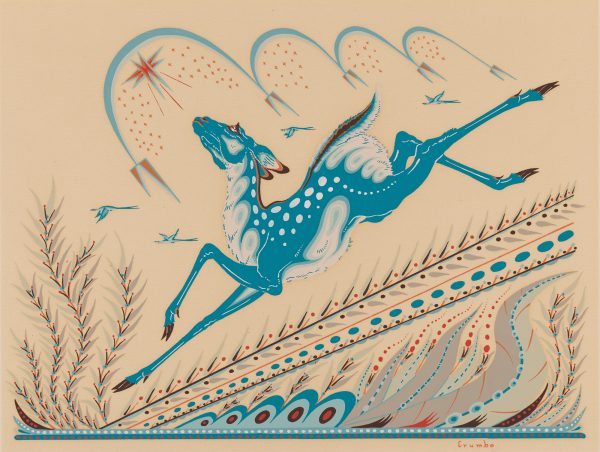
Blue Deer
Crumbo, Woodrow Wilson (called Woody)
about 1946–52
Artwork Information
-
Title:
Blue Deer
-
Artist:
Crumbo, Woodrow Wilson (called Woody)
-
Artist Bio:
American, 1912–1989
-
Date:
about 1946–52
-
Medium:
Serigraph
-
Dimensions:
15 x 20 inches
-
Credit Line:
Wichita Art Museum, Gift of the artist
-
Object Number:
1952.18
-
Display:
Not Currently on Display
About the Artwork
Crumbo issued his prints in series, with 12 being the maximum number in any single series. His intention differed from series to series. Ritual Dances and Ceremonials, for example, were intended to document and celebrate Native American cultural practices. Thus, the style is very literal: linear, two-dimensional, highly detailed, and vividly colored. It was a style that allowed Crumbo to record and represent the costumes, accessories, and choreography of Native American rituals. The Action Horse prints, in contrast, are not about description, but about the spirit, energy, and beauty of that animal so beloved by the Indians. While still two-dimensional, line, free of the constraints of literal description, whips over the paper with a life of its own.
Crumbo was born of the Potawatomi tribe in Oklahoma. Orphaned at the age of seven, he was sent to live with a Creek Indian family from whom he learned the sacred ceremonies of the Kiowa Indians. He was later adopted by a Sioux family in South Dakota. This breadth of experience helped him earn a scholarship to the American Indian Institute in Wichita, a private school founded by Dr. Henry Roe Cloud, a Winnebago Indian who dedicated his life to teaching young Native Americans music, art, and general culture. Crumbo was devoted to the study of American Indian culture in order to be able to create a pictorial record of the “history, religion, rituals, culture, way of life, and philosophies of his red brothers” (quoted from a letter from Crumbo to the art director of the University of Wichita, September 30, 1952.)